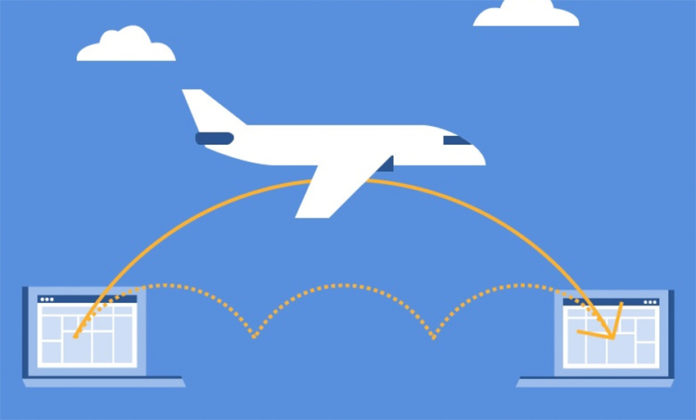WebRTC (Web Real Time Communication) the newest standard for online communication and is intended to replace Adobe’s old-man Flash. Prior to WebRTC, in order to send data (text, audio, video) from one web browser to another, the data would travel through a server (adding payload in terms of network traffic and latency). A server acts like the hub for a major airline- flights stop at the hub so that passengers can connect to their destination. Passangers may need to go through baggage claim, immigration, layovers and delays (the equivalent of the processing that may take place on the server in the middle). However, isn’t nicer (and so much faster) to fly direct? Check out the graphic below for a high level illustration of the peer-to-peer advantage of WebRTC.
Imagine if airlines had direct flights available from your local airport to every single destination in the world- the improvements to air travel would be tremendous. In much the same way, WebRTC is destined to change the web as we know it because it eliminates the need to connect through a server in order to send data. Furthermore, unlike Skype for example, WebRTC does not require any downloads or installation of software- it is a completely open platform. Many companies are sunsetting outdated communication technologies such as Flash and moving to WebRTC. Additionally, penetration amongst consumers (people with browsers that support WebRTC) is also increasing (see chart below). At Glia we believe that the companies that are taking advantage of WebRTC today are positioning themselves to become companies of the future. For this reason, the SM platform incorporates only the latest technology (including WebRTC) along with several other proprietary tech that w’ve built in house.
WebRTC Penetration
By the end of 2013 it is estimated that half of the internet population will be enabled for WebRTC. Recently, Google announced that WebRTC has over 1Billion endpoints today (this includes 750M Google Chrome users)! By the end of next month (June 2013) all of FireFox users will be enabled and shortly after Safari (and maybe even Internet Explorer) will adopt WebRTC. Although Internet Explorer is loosing market share rapidly it is still used by a significant number of individuals in the US. However, even though IE10 does not support WebRTC just yet, this latest version of IE is the first time that Microsoft has (intelligently) introduced auto updates. This functionality allows future releases of IE to roll-out new technology (such as WebRTC) and see an almost immediate full adoption. All this together bodes extremely well for the penetration of WebRTC in the coming years. Check out the chart below (and note that a recent announcement by Google shows that the expectations depicted have actually been surpassed).

Reasons WebRTC is AWESOME:
– Coded in JavaScript (essentially the Internet’s mother tongue) – Pristine audio / video quality – Real-time network adjustments based on connection speed
Reasons Flash is NOT awesome:
– Coded in Flex (a bulky and antiquated programming language) – Poor video quality and audio that is plagued with echo/feedback problems – Preset non-adjustable network that does not respond to connection speed
A Bit More on Skype
Our prediction is Skype will continue to grow but will lose overall video chat marketshare as the number of new video chat applications increase due to WebRTC’s penetration and openness. People already spend an amazing amount of time using video chat on Skype (300 million minutes each DAY– yes you are reading that right). Video chat will soon become a common everyday form communication as it becomes more tightly integrated into future products. This all makes sens- after all studies show that more than 60% of how communication is non-verbal.
A Note on U.S. Connection Speed:
Over the last few years, the average Internet in the U.S. has increased significantly. With companies such as Google building infrastructure for 1GB connections, speeds are poised to grow exponentially. This is great news for WebRTC as it means even faster “flights”. Nonetheless, our internal tests with WebRTC evidence excellent video / audio quality at speeds of less than 1MB (which represents coverage of nearly the entire US population).
The web as we know is about to change. By enabling browser-to-browser communication and “flying direct” throughout the Internet, we are entering an era of incredible speed and efficiency. To learn more about WebRTC on a technical level click here for Goole’s presentation.






